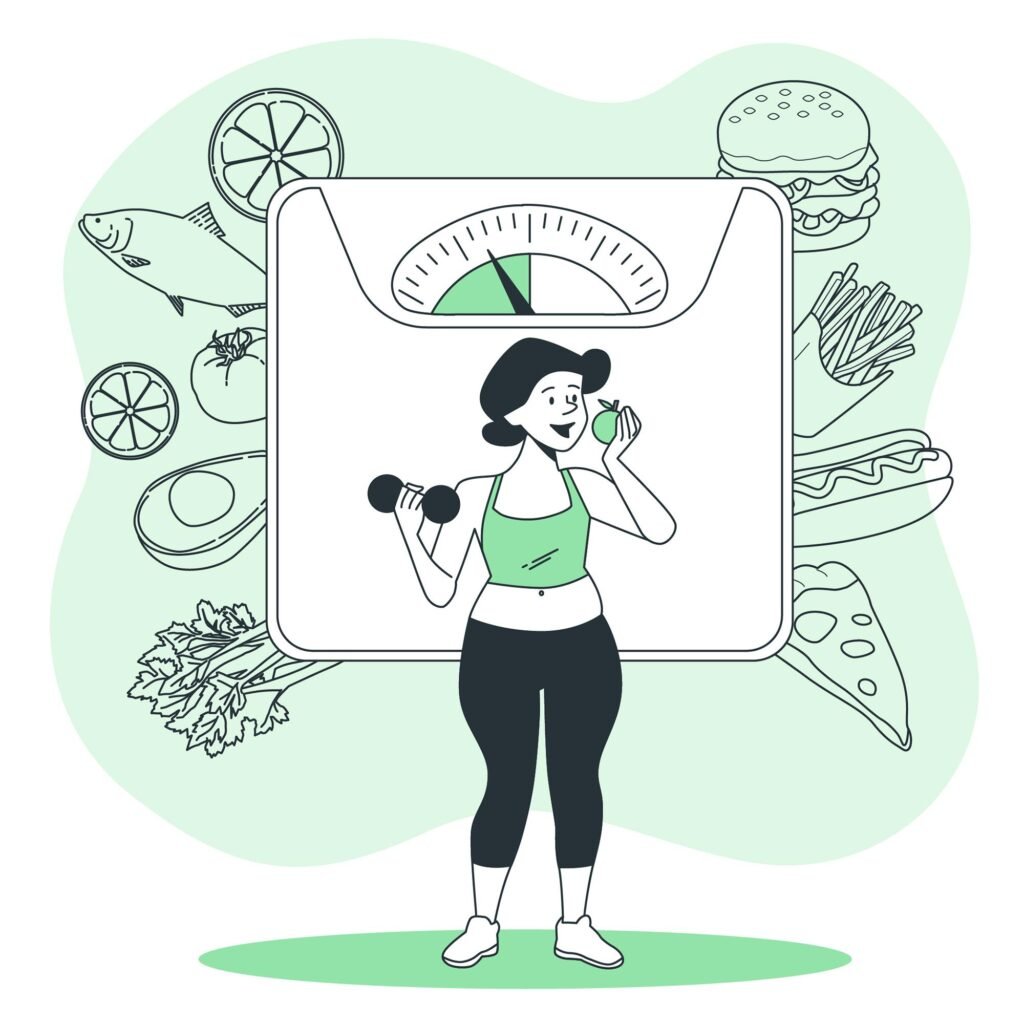Hey everyone! Let’s be real, we’ve all been there – staring at the mirror, maybe a little frustrated, and thinking, ‘I wish I could just drop a few pounds, like, yesterday!’ And hey, who hasn’t Googled something like ‘lose weight in 7 days’ at some point? You’re definitely not alone! Those quick-fix diets and challenges are super tempting, promising amazing results in no time. But here’s the thing: while it’s totally understandable to want to see changes fast, we need to talk about what’s actually healthy and sustainable. So, in this article, we’re going to ditch the unrealistic promises and focus on real, practical ways to give your weight loss a potential jumpstart and set you up for long-term success. Think of it as a friendly chat about how to feel good in your own skin, without resorting to anything crazy. Let’s get started!”
Understanding Rapid Weight Loss
A. What is “water weight” and how it affects initial results.
Okay, let’s get cozy with the concept of ‘water weight.’ Imagine your body as a bit of a storage unit, right? It keeps a certain amount of water on hand, and that amount can fluctuate. Now, things like carbohydrates and sodium (that’s salt!) have a big say in how much water your body holds onto. Carbs, in particular, like to bring along a little water when they get stored as glycogen. So, when you start a new diet, especially one where you cut back on carbs, your body uses up those glycogen stores, and along goes the water! That’s why you might see a pretty quick drop on the scale at first. It’s like your body is saying, ‘Okay, time to let go of some of this extra baggage!’ And just to reiterate, while seeing that number go down can feel awesome, it’s mostly water leaving, not necessarily fat. It’s a bit like squeezing out a sponge – you’re getting rid of some extra fluid.
B. The difference between fat loss and water weight loss.
Now, here’s where we need to be clear: water weight loss is not the same as fat loss. Think of it like this: water weight is like temporary guests staying in your body’s hotel. They come and go pretty quickly. Fat loss, on the other hand, is like renovating the hotel – it takes time and effort to make lasting changes. When you lose fat, you’re actually reducing the number and size of fat cells in your body. This process requires creating a calorie deficit, meaning you’re burning more calories than you’re consuming. This takes consistent effort over time. Water weight, as we just discussed, can fluctuate based on your diet and hydration levels. It’s a quick change, but it’s not a permanent shift in your body composition. So, while seeing that initial drop in water weight can be motivating, remember that true, sustainable weight loss comes from losing fat, and that takes a bit more time and patience.
C. The potential dangers of extremely restrictive diets.
Alright, let’s have a little heart-to-heart about those super-strict diets that promise crazy-fast results. They can be tempting, I know! But they also come with some potential downsides. Imagine trying to run a car on fumes – it’s not going to go very far, right? That’s kind of what happens when you severely restrict your calorie intake. Your body needs a variety of nutrients to function properly, and if you’re not getting enough, you could end up with nutrient deficiencies. Plus, when you drastically cut calories, your body might start breaking down muscle for energy, which is not what we want. And here’s the kicker: your metabolism might start to slow down to conserve energy, making it even harder to lose weight in the long run. It’s like your body is saying, ‘Whoa, we’re in survival mode here!’ So, while these diets might offer quick results, they’re often not healthy or sustainable, and they can even backfire in the long run. It’s always better to focus on a balanced, nourishing approach that supports your overall health.
Healthy Strategies for a 7-Day Jumpstart
A. Dietary Adjustments:
Okay, let’s talk about how to tweak your eating habits for a healthy jumpstart. Think of it like giving your body a little tune-up! We’re not talking about anything drastic, just some smart swaps and mindful choices.”
• 1. Focus on whole, unprocessed foods. “Imagine your plate as a garden – we want it filled with fresh, vibrant foods! Think lean proteins like chicken, fish, or tofu, loads of colorful non-starchy veggies like broccoli, spinach, and peppers, and a sprinkle of healthy fats from things like avocado, nuts, or olive oil. These foods are packed with nutrients and fiber, which will keep you feeling full and satisfied. It’s like giving your body the good fuel it needs to thrive!”
• 2. Reduce refined carbohydrates and sugars. “Now, let’s gently nudge those processed carbs and sugary treats to the side. Think of them as the ‘sometimes’ foods. We’re talking sugary drinks, processed snacks, and white bread. Swapping these for whole grains and natural sugars can make a big difference. It’s like decluttering your pantry and making room for the good stuff!”
• 3. Portion control. “Portion control is like being a mindful artist with your food. It’s about enjoying your meals while being aware of how much you’re eating. You don’t have to weigh everything, but paying attention to serving sizes can really help. It’s like learning to appreciate the right amount of each ingredient in your masterpiece!”
• 4. Increase water intake. “Water is your body’s best friend! It helps with everything from digestion to metabolism. Think of it as your internal cleaning crew. Aim for plenty of water throughout the day. It’ll help you feel full, especially before meals, and keep everything running smoothly. It’s like giving your body a refreshing internal shower!”
• 5. Increase fiber intake. “Fiber is like the unsung hero of healthy eating. It keeps you feeling full, supports healthy digestion, and helps regulate blood sugar. Think of it as the friendly helper that keeps things moving along. Load up on fiber-rich foods like fruits, vegetables, and whole grains. Your gut will thank you!”
B. Exercise Recommendations:
Now, let’s get moving! Exercise isn’t just about burning calories; it’s about feeling energized and strong. Think of it as a way to celebrate what your body can do!”
• 1. Combination of cardio and strength training. “Think of cardio as your body’s happy dance, and strength training as building your inner superhero. Combining both is the way to go! Cardio gets your heart pumping and burns calories, while strength training builds muscle, which helps boost your metabolism. It’s like creating a well-rounded fitness routine that makes you feel amazing!”
• 2. Aim for at least 30 minutes of moderate-intensity exercise daily. “Thirty minutes might sound like a lot, but it can be broken up throughout the day. A brisk walk, a bike ride, or even dancing to your favorite tunes counts! It’s like finding pockets of movement throughout your day to keep your energy levels up.”
• 3. Incorporate high-intensity interval training (HIIT) for short bursts. “HIIT is like a quick burst of energy that gets your heart pumping and burns calories in a short amount of time. Think short bursts of intense exercise followed by brief recovery periods. It’s like adding a little spice to your workout routine!”
• 4. Emphasize the importance of consistent movement. “Consistency is key! Even small amounts of movement add up over time. It’s like building a habit of feeling good. Find activities you enjoy and make them a regular part of your day.
C. Lifestyle Modifications:
Finally, let’s talk about those little lifestyle tweaks that can make a big difference. Think of them as the supporting cast that helps you reach your goals.”
• 1. Prioritize sleep (7-9 hours). “Sleep is like your body’s recharge button. Aim for 7-9 hours of quality sleep each night. It’s like giving your body the rest it needs to function at its best.”
• 2. Manage stress (meditation, yoga, deep breathing). “Stress can sabotage your weight loss efforts. Find healthy ways to manage stress, like meditation, yoga, or deep breathing exercises. It’s like creating a calm and peaceful space within yourself.”
• 3. Plan meals and snacks. “Planning ahead can help you make healthier choices. It’s like being prepared for success. Take some time to plan your meals and snacks for the week.”
• 4. Limit alcohol consumption. “Alcohol can add extra calories and hinder your weight loss efforts. It’s like being mindful of your choices. Limiting alcohol consumption can make a big difference.”
A Sample 7-Day Meal Plan
Okay, let’s talk about food! Now, remember, this is just a sample plan. It’s meant to give you ideas and inspiration, not to be a rigid rulebook. We’re all different, and what works for one person might not work for another. So, feel free to adjust this plan based on your own preferences and needs. Think of it as a starting point for your culinary adventure!
A. Emphasize flexibility and individual needs.
First and foremost, let’s be flexible! This meal plan is a guide, not a prison. If you don’t like a certain food, swap it out for something you do enjoy. The goal is to create a meal plan that you can stick to and enjoy. Also, listen to your body! If you’re feeling extra hungry, add a healthy snack. If you’re not feeling as hungry, eat a smaller portion. It’s all about finding what works best for you. Your body is your best guide!
B. Include a sample day’s menu with calorie guidelines.
Let’s take a peek at a sample day, just to give you an idea. Remember, calorie needs vary, so this is just a general guideline. We’ll aim for a balanced approach with plenty of protein, veggies, and healthy fats.
• Sample Day:
o Breakfast (around 300 calories): Oatmeal with berries and a sprinkle of nuts. (Think fiber and healthy fats!)
o Lunch (around 400 calories): Large salad with grilled chicken or tofu, mixed greens, and a light vinaigrette. (Protein and lots of veggies!)
o Dinner (around 400 calories): Baked salmon with roasted broccoli and sweet potato. (Healthy fats, protein, and complex carbs!)
o Snacks (around 100-150 calories each, 2 snacks total): Apple slices with almond butter, or a handful of almonds.
“Remember, these calorie counts are approximate. You can adjust them based on your own needs and goals. The important thing is to focus on whole, unprocessed foods and balanced meals.”
C. Suggest healthy snack options.
Snacks are your friends! They can help you stay satisfied between meals and prevent overeating. Here are a few healthy snack ideas:
• “A handful of mixed nuts.”
• “Greek yogurt with berries.”
• “Vegetable sticks with hummus.”
• “A small portion of cottage cheese.”
• “Hard-boiled egg.”
• “Edamame pods.”
Choose snacks that are high in protein and fiber to keep you feeling full and energized.
D. Stress that this is a sample, and not a rigid plan.
Again, I can’t stress this enough: this is just a sample! Don’t feel pressured to follow it exactly. The goal is to give you ideas and inspiration, not to create a rigid set of rules. Feel free to mix and match meals and snacks based on your own preferences and needs. And most importantly, enjoy your food! Eating healthy should be a pleasurable experience, not a chore.
Setting Realistic Expectations
Okay, let’s talk about what you can actually expect from a 7-day jumpstart. It’s so important to have realistic expectations, so you don’t get discouraged. Think of this chapter as a friendly guide to navigating the ups and downs of weight loss.
A. Expected weight loss range in 7 days (emphasize that it varies).
Now, here’s the million-dollar question: how much weight can you expect to lose in 7 days? The truth is, it varies a lot. It depends on your starting weight, your metabolism, your activity level, and so many other factors. Some people might see a 1-2 pound drop, while others might see a bit more, especially if they’re losing water weight. But remember, rapid weight loss is often mostly water, and that’s not the same as fat loss. It’s like planting a seed – sometimes you see sprouts quickly, other times it takes a little longer. Don’t compare your journey to others, as everyone is unique.
B. Importance of focusing on overall health improvement, not just the number on the scale.
Let’s shift our focus from just the number on the scale to something much bigger: your overall health! Weight loss is just one piece of the puzzle. Think about how you feel – are you more energized? Are you sleeping better? Are you feeling stronger? Those are the real victories! It’s like focusing on the strength of the tree, not just the number of apples. Focusing on health improvements creates a much more positive and sustainable journey.
Plus, remember that if you practice sport while starting a diet you may keep the same weight on the scale BUT you are gaining muscles and losing fat!
C. The likelihood of regaining water weight after returning to normal eating habits.
Okay, let’s be honest: if you’ve lost mostly water weight, it’s likely to come back once you resume your normal eating habits. That’s just how the body works. It’s like a sponge that reabsorbs water. Don’t let this discourage you! The initial weight loss can be a great motivator, but remember that true, lasting change comes from creating healthy habits. Think of it as building a solid foundation instead of just painting the surface.
D. The importance of celebrating non-scale victories (increased energy, better sleep).
Let’s celebrate those non-scale victories! Did you notice you have more energy to play with your kids? Did you sleep better last night? Are your clothes fitting a little looser? Those are the signs that you’re making progress! It’s like noticing the little flowers blooming along the path. These victories are just as important, if not more, than the number on the scale. They are the true signs of a healthier you, and deserve to be celebrated!
Transitioning to Long-Term Healthy Habits
Okay, you’ve gotten a great jumpstart! Now, let’s talk about how to keep the momentum going and turn these healthy habits into a lasting lifestyle. Think of this chapter as your guide to building a solid foundation for long-term success.
A. Strategies for sustainable weight management.
The key to long-term success is sustainability. We’re not talking about quick fixes anymore; we’re talking about making changes you can live with! It’s like planting a garden that you can enjoy for years to come.
• Gradual increase in calorie intake to a healthy maintenance level. “After your 7-day jumpstart, don’t just jump back to your old eating habits. Gradually increase your calorie intake to a healthy maintenance level. This will help you avoid regaining any lost weight and ensure you’re getting enough nutrients. It’s like slowly watering the garden, instead of flooding it.”
• Continued focus on whole, unprocessed foods. “Keep those healthy eating habits going! Continue to focus on whole, unprocessed foods like lean proteins, fruits, vegetables, and whole grains. These foods will provide your body with the nutrients it needs to thrive. It’s like consistently tending to the garden, and watching it flourish.”
• Regular exercise routine. “Make exercise a regular part of your life. Find activities you enjoy and aim for at least 30 minutes of moderate-intensity exercise most days of the week. It’s like making sure the garden gets sunshine and fresh air.”
• Mindful eating practices. “Pay attention to your hunger and fullness cues. Eat slowly and savor your food. Avoid distractions while eating, such as watching TV or scrolling on your phone. It’s like truly appreciating the harvest from your garden.”
B. The importance of consistency and patience.
Rome wasn’t built in a day, and neither is a healthy lifestyle! Be patient with yourself and don’t get discouraged if you have a setback. Consistency is key, even small steps add up over time. It’s like knowing that even small seeds, with care, will grow into something beautiful.
C. Seeking professional guidance (dietitian, personal trainer) if needed.
If you’re struggling to make these changes on your own, don’t hesitate to seek professional guidance. A registered dietitian can help you create a personalized meal plan, and a certified personal trainer can help you develop an exercise routine that’s right for you. It’s like asking a master gardener for advice.
D. Setting realistic long term goals.
Set realistic and achievable long-term goals. Don’t try to lose too much weight too quickly. Focus on making gradual, sustainable changes. It’s like planning for the garden’s future, not just for the next harvest.
Conclusion
“So, we’ve talked about a lot, haven’t we? We’ve explored how to give your weight loss a healthy jumpstart, and more importantly, how to build a lifestyle that supports your long-term well-being. Remember, the journey to a healthier you isn’t a race; it’s a marathon, and we want to make sure you enjoy the scenery along the way.”
“We’ve learned that rapid weight loss is often temporary, mostly water weight, and not the same as true fat loss. It’s like a quick rain shower, refreshing, but not the long-lasting nourishment the garden needs. The real magic happens when we focus on creating sustainable habits. That’s where the lasting change comes from, like planting deep roots that allow your personal garden to thrive through all seasons.”
“The most important takeaway is this: focus on your overall health and well-being, not just the number on the scale. Celebrate those non-scale victories – the increased energy, the better sleep, the feeling of strength and vitality. Those are the true signs of progress! It’s like admiring the growth of the whole plant, not just a single bloom.”



